Boka Artist Residence on the Adriatic Coast - Winning Designs
By Bustler Editors|
Tuesday, Sep 25, 2012

Related
Three winning designs have recently been announced in the international competition for the architectural and urban planning design of Boka Artist Residence in the Bay of Kotor, Republic of Montenegro. The competition, organized by architectural studio Sinestezia from Belgrade, Serbia, announced Japanese architect Tomohiro Hata from Kobe as the first prize winner.
Out of 30 submitted entries from 17 countries, the second place went to an architectural team from Ljubljana, Slovenia: Ziga Misjak, Vesna Lenart, Jana Petkovic, while the third place was given to an architectural team from Taiwan: Kuan-yi Ho, Kuan-chi Feng, Pei-Chi Chen, Shih Chun-ren.
The competition brief envisions Boka Artist Residence as a stimulating place for all forms of activities including theory, visual arts, architecture, design, literature, music, new media, cultural production, and science, encouraging dynamic intercultural exchange, interactions, and cooperation, as well as connecting Montenegro with the countries of the region, Europe and rest of the world.
The International Jury was composed of:
- Colin Fournier, professor at The Bartlett School of Architecture, UCL; 2004. RIBA winner, for the Kunsthaus Graz project;
- Paul Alezraa, director of the Lordculture consultancies which develops programs for cultural institutions globally (Guggenheim Museum Bilbao, Centre Pompidou,Louvre…);
- Slobodan Popović, architect, Director of Herceg Novi Development and Construction Agency;
- Milica Lopičić, architect, Executive Board member of EXPEDITIO, Montenegro non-governmental organization with mission to encourage sustainable spatial development and enhancing urban and rural areas in Montenegro and SEE region through activity in the fields of sustainable architecture, cultural heritage and urban planning;
- Ana Zatezalo Schenk, architect, founder of Sinestezia. Her work has been published and exhibited at the Venice Biennale, Beijing Architecture Biennale, MIPIM in Cannes. She was a jury member at Harvard School of Architecture, Columbia University and Pratt Institute;
- Irene Pascual, Artist / Art Manager and Curator at glogauAIR Berlin;
- Dubravka Sekulić, architect, teaching assistant at the Faculty of Architecture, University of Belgrade. In 2004-2005 she was involved in running alternative cultural space in former printing factory BIGZ, in Belgrade.
Deputies of jury members were Ivana Nenković, architect, Belgrade; and Saša Klopanović, philosopher, Belgrade.

WINNER - FIRST PRIZE: Tomohiro Hata
Japan, Kobe
STONE TERRACE
We propose an artist residence that is like stone geographical features expanding along with gentle slope. Stone walls are built along to the contour-line of the slope with minimum digging. Only this way, all the element of this proposal is to be made. The stone walls are exterior of building, pedestrian route, forum and pool like terrace paddy field. To observe the geographical features, suitable places for each function are found and create the scenery like as geographical up and down coming to be the stone walls.
In the same way that there is no identical place on geographical features, all places and buildings are different each other and have various plan, although it’s planned by only one primitive way. In the scenery of stone culture which is traditionally loved here, unique and new building appears as if it has existed since a long time ago. Moreover, stone is the prominent material that stays itself calmly in the lapse of time.
The stone walls will slowly be weathered covered by green and come to be the more harmonizing place with surrounding environment. “STONE TERRACE” is the way of new building that exist no other place than this place.

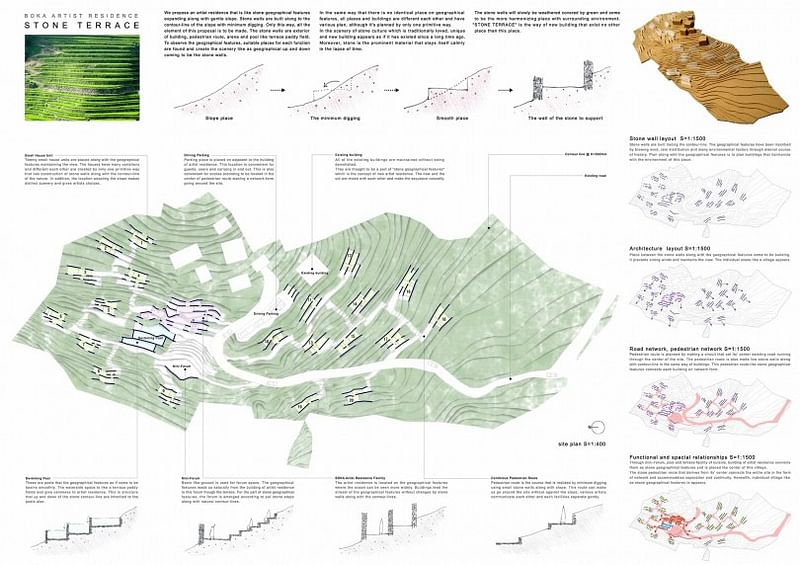

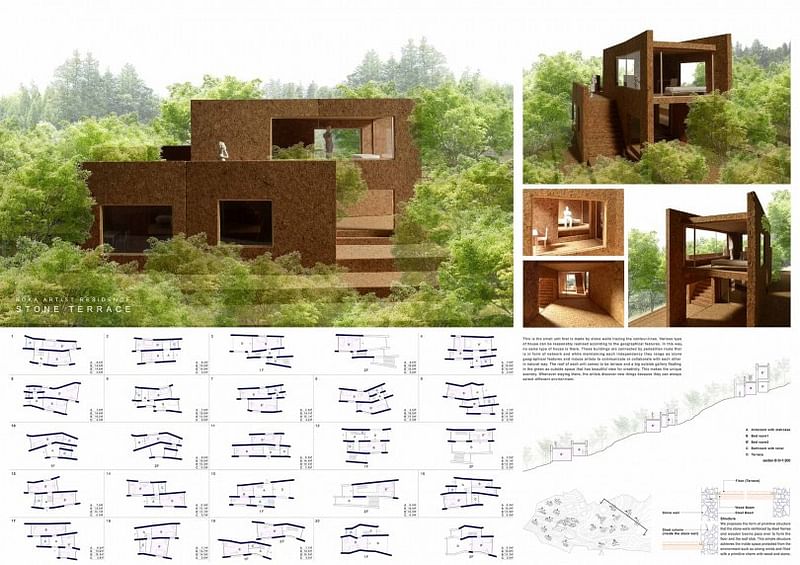
SECOND PRIZE: Ziga Misjak, Vesna Lenart, Jana Petković
Ljubljana, Slovenia
The main goal of urbanistic and architectural intervantion on the site is to let existing structures and vegetation to speak for themselves. They are to be more of an everpresent reality then a leading ideal. Therefore we don't propose for the existing houses to be demolished and neither we propose any exact functional or formal renovation. The old village is to be left as it is and to slowly become a garden. As such the existing fabric becomes a spiritual centre of the site, a place for unintended meetings and sparks of intuition. The old village garden is a public space with intimate qualities and in this way it naturally demands the vicinity of the remaining public program - a pool and a communal building with an auditorium on the roof, all of them oriented towards the west to catch beautiful views of Boka Kotorska bay. Residential units for artists are placed around this centre in smaller groups of 3 to 5 houses.
They function as almost independent communities in which people have their private places but use the outside as a meeting space, they try to fulfil their basic needs together in the everpresent natural environment. Simple cubic houses with thick walls and a minimal number of openings are therefore functionally connected to the communal 'wall' with toilets, a kitchen, a storage room and a stage.
Artists room is a simple space with bed and wardrobe niches hidden in the thick wall and with one big window, providing a clear focus. The main material used on the site is local stone and the construction of a residential unit corresponds to local weather conditions: green roof soaks and keeps the water, big window openings are shaded with big perforated steel shadings and a thick northern wall provides cover against strong northern winds.
The rest of the site is covered with local vegetation in which narrow paths connect groups of houses with central garden, pool and communal building. We believe that local environment with its weather, materials and vegetation provides the perfect conditions for conncentration and creativity. Therefore the proposed architectural solution is simple, rough and connected with the soil.
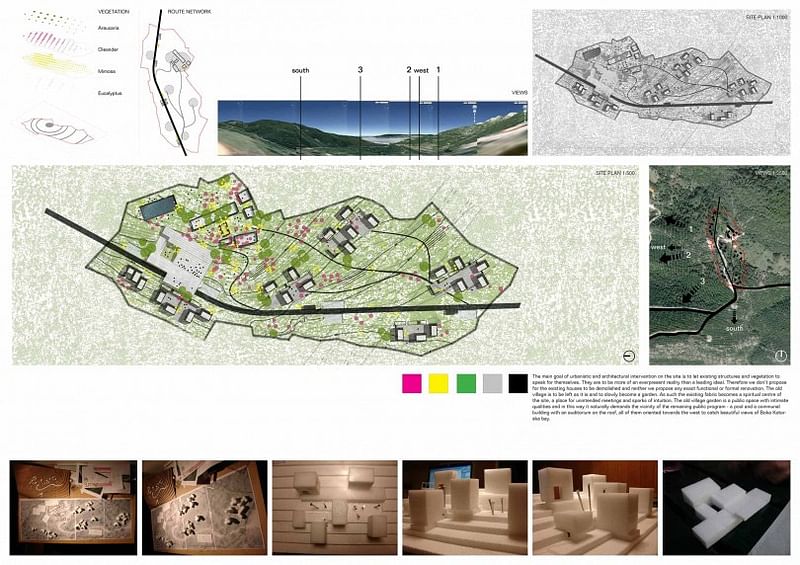



THIRD PRIZE: Kuan-yi Ho, Kuan-chi Feng, Pei-chi Chen, Chun-ren Shih
Taipei, Taiwan
Boka Resident should be like a secret garden where visitors can find various arts, artists and life as surprises. The most wonderful thing isn’t the art work but the creative process, so this is the place which stimulates imaginations and provides a diverse of fields for the interactions between artists and visitors.
In plan, the residential units are arranged at the lowest area, the visitors must go through most public space such as kitchen, reading room and swimming pool which increases the opportunities to discover the amazing nature and by overlapping the route of visitors and artists, they might chance to meet each other and be inspired with a brand new idea. On the whole, by a continuous wall with different height and different transparency, interior and exterior spaces are recombining in unexpected ways to maximize the connection between various people and activities. Following the direction of the wall, you’ll catch a view of limitless ocean, by the random open on the wall you’ll suddenly be part of the scenery. The residential units are defined by two walls mainly. Among the units, there are arranged free outdoor spaces which provide a flexible field for residents’ expansion and a terrace for the small community gathering at night. In every bedroom, there’s an operable louver which you can open it to feel closer to the nature and to get a panorama of the shore. The opened louver will also become the canopy of the room.
In the field, you’ll be surrounded by not only energetic arts but also a cozy environment with natural atmosphere. The volumes are formed in ladder shape because of the topography, there’s no specific edge between spaces but a natural elements such as stone, water to combine each spaces and to link up the whole Boka Artist residents.
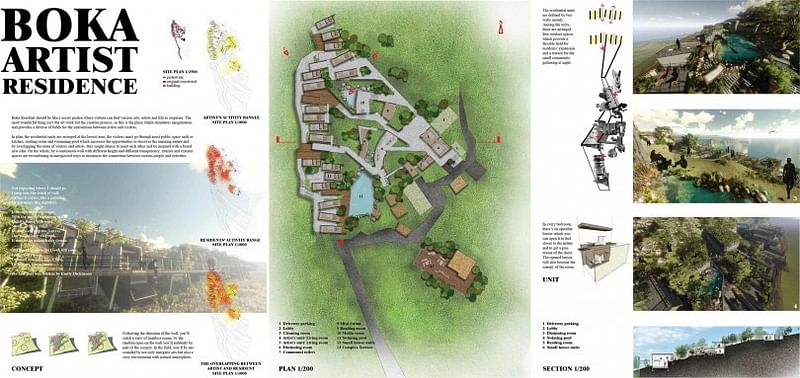
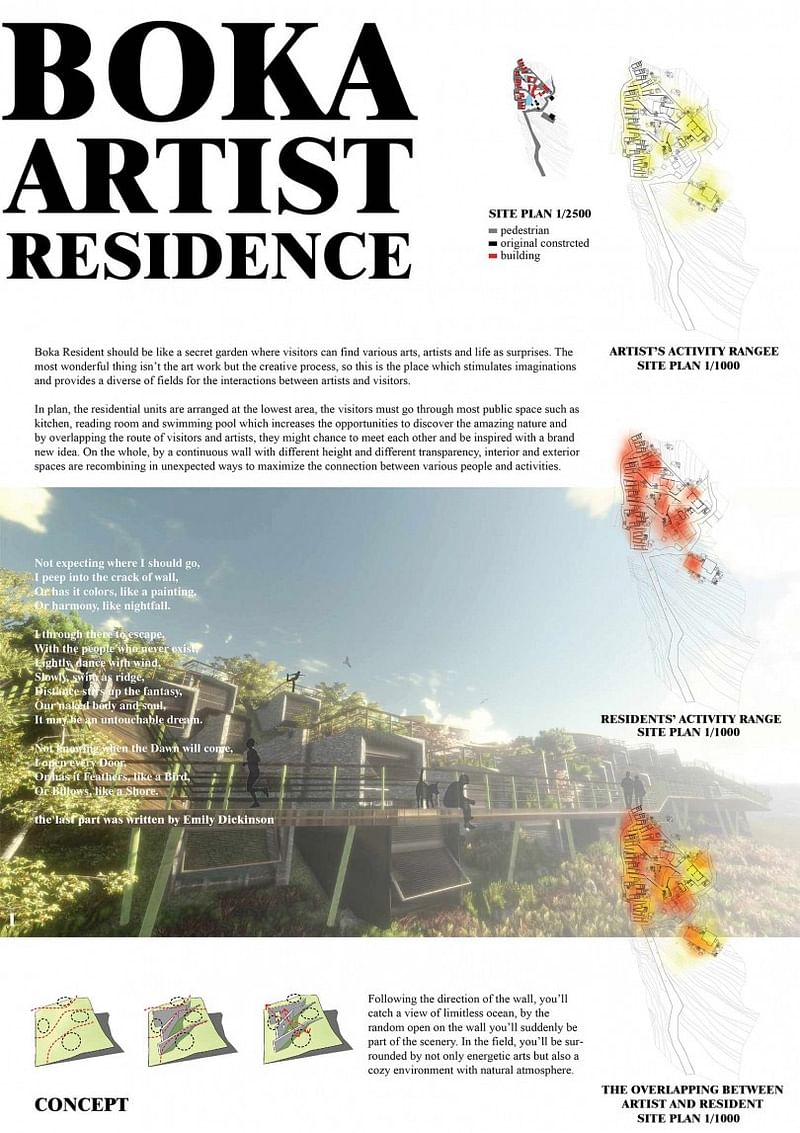

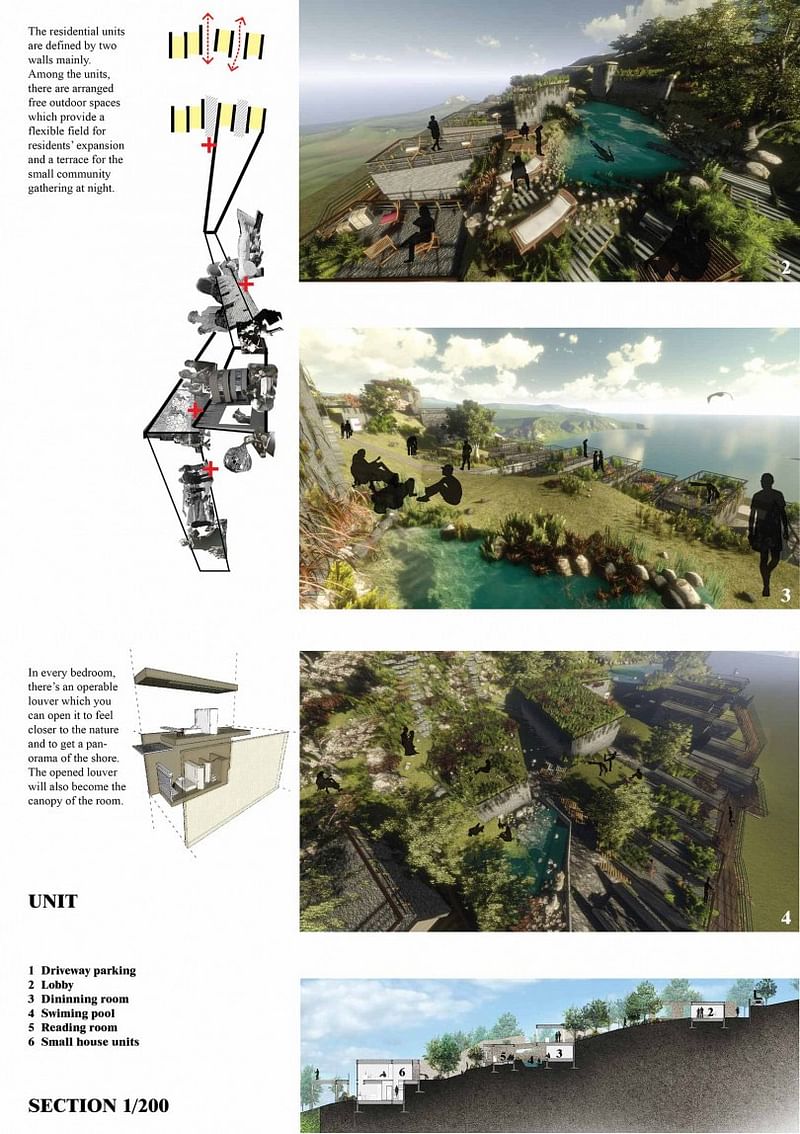
All images courtesy of Boka Artist Residence competition.

Share
0 Comments
Comment as :